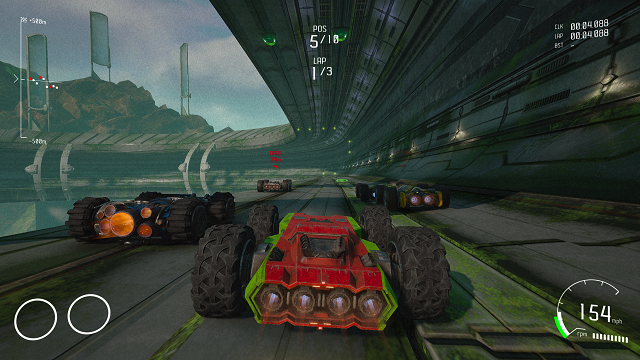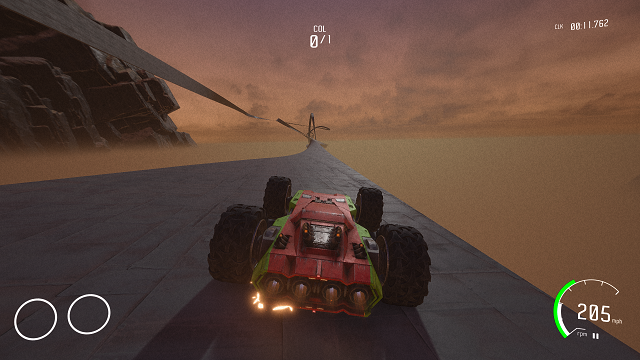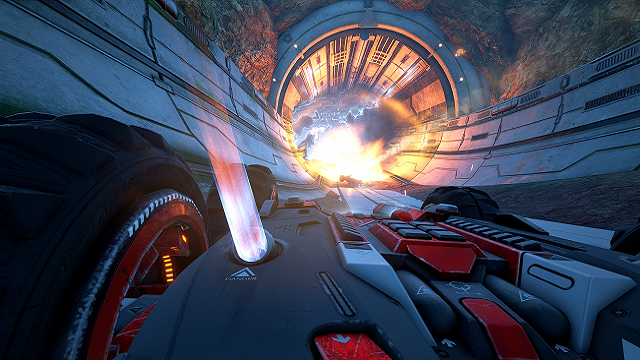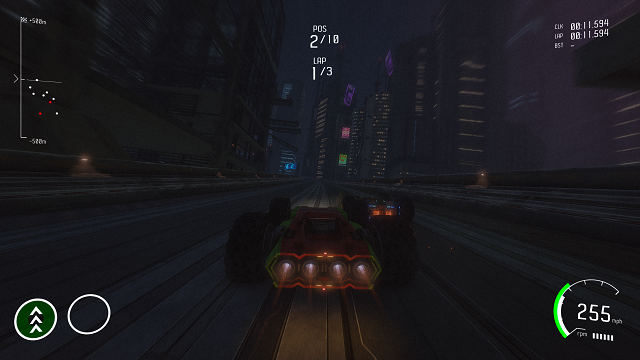One great thing about the wide gaming market nowadays is that no subject is too niche. If you have a favorite forgotten PS1 title, you can bet that someone out there is at least trying to get together a modern interpretation. These revivals might not always be huge blockbusters, but a smaller scale sometimes matches better with their inspirations. Such is the case with Grip: Combat Racing, a spiritual successor to Psygnosis’ Rollcage games. Grip is a fun time if you’re looking to blast cars into dust. After all, the world can always use more arcade racers.
At its core, Grip is a solid driving game, even without the bells and whistles. Driving feels responsive and you have full control over your vehicle whenever you’re on the ground. Or the ceiling. Whenever your tires are touching the track, you get me. You blast around tracks at high speeds, and I don’t just mean in a straight line. Tracks in Grip are a roller coaster, sending you on your side and upside down often. You’re equipped with miniguns and missile launchers, and you’ll sometimes be aiming then straight down at a racer underneath you. When this works, it’s endlessly fascinating, especially considering how free you are to take different paths along most of the track.
Grip: Combat Racing Review – Sending You For A Loop

Of course, that positive is also a negative depending on what track you’re currently racing on. Tracks that stick to half-pipes and other enclosed spaces really showcase what makes the game works. These live alongside a whole lot of wide open tracks that encourage more exploration. However, the first few times you go through them, it’s very hard to stick to the critical path. Especially considering that these open tracks are filled with props that send your car flying in all the wrong directions.
You see, your combat racer is very sticky. As long as you’re going fast enough, it will stick to the ground even as you’re looping around a tube. It’s the thing that makes Grip work, but it also leads to some frustration. There are just too many spots in too many tracks where the game lets you climb up a mountain Skyrim-style and give up your place to the rest of the pack. Hitting an obstacle isn’t just a hindrance in Grip, it’s a death sentence. Unfortunately, there are numerous props blocking your way around every corner, even on the good tracks. Your air control is nonexistent and you feel very slow as you fall from whatever high point you climbed up to scaling a rock formation.
Not to mention that these moments of high-speed hijinx also showcase some of the game’s technical limitations. I often found myself flipping through geometry or clipping into the world if I rammed scenery the wrong way. Cars in Grip go extremely fast by design, so crashing is inevitable and it shouldn’t lead to automatic failure. And yet, more than once, I found myself wedged into a crevice that I couldn’t escape from. The developers know this is an issue since the back button acts as an automatic reset. That doesn’t make the problem any better.
Grip: Combat Racing Review – Battle Mode and Carkour

Once you get a handle on track layouts, the game really opens up. You have a full single player campaign where you cycle through various tournaments that introduce you to each mode of play. There are standard races where the winner is the person who crosses the finish line first. Ultimate races score players on both race position and how many hits they can get with the various weapons. There’s a Burnout-style Eliminator mode where the person in last blows up at set time intervals, a race focused only on speed with turbo boosts replacing all power-ups, and a standard time trial. It’s hard to differentiate between the different modes as they’re thrown at you in the single player, but it’s a good variety.
Grip: Combat Racing also tries its hand at some more offbeat modes, to various degrees of success. You’ve got a standard battle mode that plays out like a Mario Kart demolition derby, with a couple other modes promised for the future. I have the same problem here as I do with most racing battle modes. The weapons were obviously designed to be fired far ahead of you, so it’s awkward to try to shoot them at opponents passing by in a circle. This is no Twisted Metal, and even that franchise can’t seem to figure out how to do car combat in the modern age. A neat diversion, but not where you should spend most of your time.
Far more interesting is “Carkour”, a platforming mode where you use the unique abilities of the Grip jetcar to bounce across floating platforms and reach the end of the track. I am almost certainly not skilled enough to get far here, but the levels I could beat give off a strong Trials vibe. With some work, this could be a full game all its own, and the challenge was fun to try to overcome. I imagine that someone at GDQ will be trying their hand at speedrunning through these obstacle courses before long.
Grip: Combat Racing Review – Feel The Rhythm
No matter what you’re doing in Grip, you won’t be able to escape the feeling of the 90s. The entire game sounds like a drum machine, blasting industrial tunes that call back to the days of Rollcage. The graphics are sometimes just serviceable, and there’s not a lot of flair in the overall presentation. The game impresses when it follows your car as you bounce from one side of the track to the other. The camera flips along with the car, providing amazing visual feedback for your daring feats. Gameplay is priority number one here, and it shows.
Grip Combat Racing takes the arcade racing of the PS1 days into the modern era. It has a lot of different modes to play through, ranging from basic racing all the way to weird platforming. It’s a type of variety that’s just not common in this day and age and that’s commendable. Still, the issues with the track layout and the so-so presentation mean that this game won’t Grip you for long. It’s great for a Sunday drive, but it’s not going to hold your attention forever.
Grip: Combat Racing was reviewed on Xbox One X via a digital code provided by the publisher.
-
Great Gameplay Fundamentals
-
Insane Track Layouts
-
Wide Variety of Modes
-
Battle Mode is Nothing Special
-
Obstacles Are A Huge Nuisance
-
Mediocre Presentation








